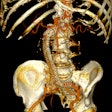Dear Advanced Visualization Insider,
Prostate cancer diagnosis is difficult in the best of circumstances. Even MRI doesn't always reveal the small tumors that high levels of prostate-specific antigen sometimes predict. As for biopsy, it may be the gold standard, but it is difficult, invasive, and bloody unreliable.
Enter MRI-based computer-aided detection (CAD) for prostate cancer, a project that Dutch researchers from Radboud University Medical Center in Nijmegen have been fine-tuning for years. Targeting the intermediate and aggressive tumors that are most likely to harm the patient, prostate CAD delivers sensitivities and specificities on par with those of experienced radiologists when used alone, and near-perfect results when combined as a second reader with radiologists. Get the rest of the story here.
Meanwhile in Germany, researchers from the Institute for Clinical Radiology at Ludwig-Maximilians University are pushing interventional radiology training into the future by building new vessel models for complex real-life image-guided interventional simulations.
It's a useful goal for a rapidly growing field that must continuously teach its trainees new techniques and procedures with an ever-expanding list of materials to work with. Find out how they're doing it by clicking here.
In thoracic imaging, another Dutch team has written a new chapter in tuberculosis (TB) diagnosis with a robust new tool to improve diagnosis with CAD. According to Rick Philipsen and colleagues, also from Nijmegen, analyzing x-ray images for patterns consistent with TB is complicated by tremendous variation in the images owing to different acquisition settings and different x-ray systems.
The researchers found a way to "normalize" the x-ray images from different digital radiography systems before they applied their CAD algorithm, revealing common patterns in the lungs of patients with TB. The technique can readily be applied to CT as well. For a look at their results, click here.
For the rest of the news in advanced visualization techniques and 3D, we invite you to scroll through the links below, right here in your Advanced Visualization Community.















